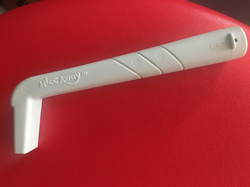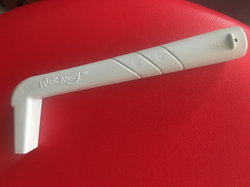
HiccAway, the device based on science and invented to relieve hiccups. Credit UT Health San Antonio
“I was thinking, how can I improve this?” — Dr. Ali Seifi of the Long School of Medicine at UT Health San Antonio, referring to hiccups in his patients.
SAN ANTONIO (PRWEB)
October 20, 2020
A neuro-intensive care physician at UT Health San Antonio has invented a science-based way to stop hiccups.
While he was working as an anesthesiologist 20 years ago, Ali Seifi, MD, FACP, FNCS, saw many surgery patients in the recovery room who developed hiccups. The annoying spasming of the diaphragm is even more of a nuisance when one has had surgery.
“I was thinking, how can I improve this?” Dr. Seifi said.
A hiccup is an involuntary contraction of the diaphragm, a thin sheet of muscle that separates the lungs from the abdomen and regulates breathing. The diaphragm contracts out of rhythm. This causes the vocal cords and larynx to swiftly close and the lungs to take in oxygen quickly. The body reacts with the classic hiccup sound.
Although hiccups usually are temporary, some cases may last for hours or days and could signal a medical problem. The longest case of hiccups reportedly lasted more than 60 years.
“There have been no clear medications for hiccups,” Dr. Seifi said. “The only drugs prescribed are psychiatry medications that do stop the spasms but make the patients sleepy. There also is no device to treat hiccups. A few devices were patented or proposed for provisional patents, but they never made it to the stage of being available to people.”
Dr. Seifi set out to invent a treatment.
His brainchild is shaped like a smoker’s pipe. On one end, the tube has two pinholes on opposite sides. These are covered by a valve or cap that can be adjusted for adult or child settings. This end is to be submerged into a cup of water.
The other end is a mouthpiece from which the user draws water through the pipe. The device is called HiccAway, a name conceived by medical students and residents attending rounds with Dr. Seifi.
“This is not a regular straw,” Dr. Seifi said. “To drink water through it, you need lots of effort and lots of negative pressure inside your chest. The valve causes you to forcefully suction the water from the cup, and when you do, after a few seconds the first sip of water enters the pipe and goes into your mouth.”
This does two things, Dr. Seifi said. Because of the severe negative suction, it pulls down the diaphragm, which triggers the phrenic nerve that regulates the diaphragm.
When the water enters the mouth, the brain wants to swallow it, so it closes the epiglottis, the flap in the throat that prevents food or water from entering the windpipe and lungs. “This is the time when the vagus nerve also gets activated,” Dr. Seifi said.
Stimulating the vagus nerve blocks signals to the vocal cords and eases hiccups.
“That was the idea that came to my mind,” Dr. Seifi said. “What if we, for a few seconds, forcefully triggered both nerves together?”
HiccAway does that, he said. By forceful suction, the diaphragm and phrenic nerve are activated, and at the same time, the water comes into the mouth and swallowing occurs. The vagus nerve is triggered and the hiccup goes away.
“We have tested it on a 1-year-old child. It worked,” Dr. Seifi said. “At any age that a person can drink water through a straw, it works for them.”
UT Health San Antonio, on behalf of The University of Texas System Board of Regents, patented this technology and granted an exclusive worldwide license to Aim Dynamics of Longmont, Colo., to market the invention.
“Honestly I am proud that this is a scientific device, because other ‘cures’ for hiccups are like voodoo things, but this is purely science,” Dr. Seifi said.
Dr. Seifi is an associate professor in the Department of Neurosurgery and a physician with UT Health Physicians, the clinical practice of the Joe R. and Teresa Lozano Long School of Medicine. He oversees the care of patients in University Hospital’s Neuro Intensive Care Unit.
Dr. Seifi received his medical degree in 1996 from Shiraz University of Medical Sciences (SUMS) in Iran. He did his first residency in anesthesiology and critical care at SUMS and his second residency in internal medicine at New Jersey’s AtlantiCare Regional Medical Center. His education culminated with two years of a neuro-critical care fellowship at Thomas Jefferson University in Philadelphia.
# # #
The Long School of Medicine at The University of Texas Health Science Center at San Antonio is named for Texas philanthropists Joe R. and Teresa Lozano Long. The school is the largest educator of physicians in South Texas, many of whom remain in San Antonio and the region to practice medicine. The school teaches more than 900 students and trains 800 residents each year. As a beacon of multicultural sensitivity, the school annually exceeds the national medical school average of Hispanic students enrolled. The school’s clinical practice is the largest multidisciplinary medical group in South Texas with 850 physicians in more than 100 specialties. The school has a highly productive research enterprise where world leaders in Alzheimer’s disease, diabetes, cancer, aging, heart disease, kidney disease and many other fields are translating molecular discoveries into new therapies. The Long School of Medicine is home to a National Cancer Institute-designated cancer center known for prolific clinical trials and drug development programs, as well as a world-renowned center for aging and related diseases.
The University of Texas Health Science Center at San Antonio, also referred to as UT Health San Antonio, is one of the country’s leading health sciences universities and is designated as a Hispanic-Serving Institution by the U.S. Department of Education. With missions of teaching, research, patient care and community engagement, its schools of medicine, nursing, dentistry, health professions and graduate biomedical sciences have graduated more than 37,000 alumni who are leading change, advancing their fields, and renewing hope for patients and their families throughout South Texas and the world. To learn about the many ways “We make lives better®,” visit http://www.uthscsa.edu.
Stay connected with The University of Texas Health Science Center at San Antonio on Facebook, Twitter, LinkedIn, Instagram and YouTube, and visit our online Newsroom.
To see how we are battling COVID-19, read inspiring stories on Impact.

